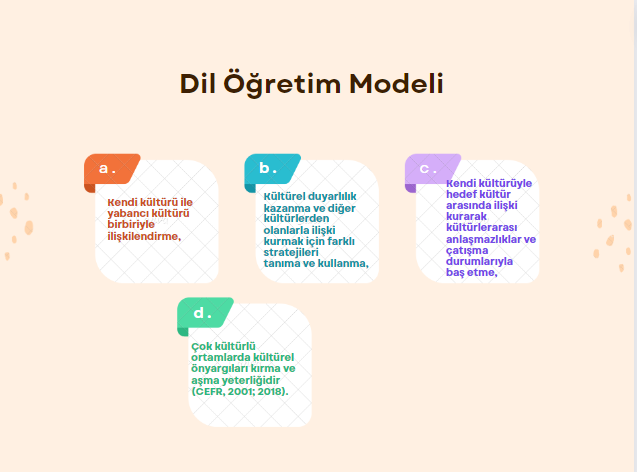Language Center
Language Teaching Model
Ostim Technical University Language Application and Research Center also provides education in different foreign languages, particularly Turkish and English. In addition to communicative skills such as reading, writing, speaking and listening, critical thinking, interpreting, creative thinking, producing, taking responsibility for one's own learning, working collaboratively, and problem-solving skills, which are the basis of individual development and language learning, are also aimed to be acquired. It also takes into account the need to recognize and respect universal cultures and raise awareness of cultural values. In this framework, the action-oriented approach proposed by the Common European Framework of Reference as a language teaching model has been adopted as the primary approach of the program. The student-centered, action-oriented approach in the Teaching Turkish as a Foreign Language Program treats students as members of society who use language and prioritize socio-cultural values, are not limited to language, and perform the tasks they need to fulfill (CEFR, 2001; 2018). Communicative language use, which includes language learning, encompasses the actions of individuals who develop multiple competencies both as learners and as social actors. Learners draw on these competencies in a variety of contexts, conditions, and constraints to perform language tasks for producing and receiving texts on specific topics from their life domains. The experiences learners gain from such communicative activities can lead to developing or changing their competencies (CEFR, 2001; 2018). In this sense, the areas of use of language according to the roles that learners will assume in social life can be shown as follows:
| Daily Life: | Food and beverage, mealtimes, table manners, public holidays, working hours, leisure activities | |
Living conditions: | House conditions, welfare status | |
Interpersonal relationships: | Relationships between men and women, family structures and relationships, relationships in the work environment, etc. | |
Values, beliefs, and attitudes: | Regional cultures, tradition and social change, history, especially symbolic historical figures and events, foreign countries, peoples, countries, politics, art, religion, humor | |
Body language: | Body language communication is traditionally used in different cultures in language learning and its transfer to other cultures. | |
| Social traditions: | Concerning hospitality: punctuality, gifts, length of stay, returning home, etc. | |
Rituals: | Birth, marriage, celebrations, festivals, dances, etc. | |
The socio-cultural information listed in the Turkish as a Foreign Language Teaching Program is given for each level and grade concerning the themes. The question to be answered in the process of providing intercultural awareness and teaching following this program is what kind of world knowledge or knowledge about other cultures the learners will need to apply (CEFR, 2001; 2018). The content of the intercultural interaction will also be determined in line with the response given. Thus, in the classes where the program is implemented, the learner is expected to develop the following intercultural skills:
a. Associating one's own culture with foreign culture,
b. Different strategies for gaining cultural awareness and engaging people from other cultures, recognition and use
c. Dealing with intercultural disagreements and conflict situations by establishing a relationship between own culture and the target culture,
d. The ability to break down and overcome cultural prejudices in multicultural environments (CEFR, 2001; 2018).

